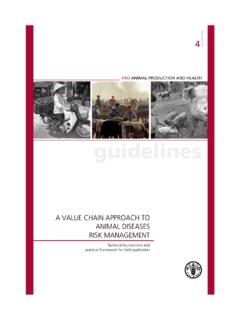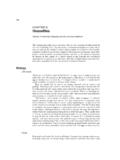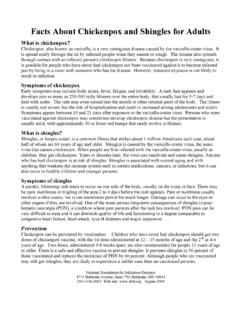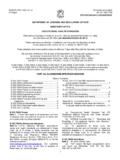Transcription of DISEASES OF GERANIUM - Connecticut
1 Dr. Sharon M. Douglas Department of Plant Pathology and Ecology The Connecticut Agricultural Experiment Station 123 Huntington Street, P. O. Box 1106. New Haven, CT 06504. Phone: (203) 974-8601. Fax: (203) 974-8502. Email: DISEASES OF GERANIUM . Geraniums continue to be one of the most popular bedding plants in the United States and in Connecticut . While there is still a demand for the traditional florist's or zonal geraniums from cuttings (Pelargonium X hortorum) they are also joined by seed-grown hybrids, ivy geraniums (P. peltatum), Martha Washington or Regal geraniums (Pelargonium X domesticum), and scented and perennial geraniums ( GERANIUM spp.) in the landscape. Although over 45 different DISEASES have been described on GERANIUM , most of them fortunately don't occur with any frequency. However, it is still important to be able to accurately identify disease problems when they do occur.
2 Since the method of propagation used for geraniums has an impact on the types of DISEASES that are encountered, the DISEASES in this discussion are categorized on the basis of how the geraniums are propagated. DISEASES are also organized by the type of the causal agent or pathogen ( , fungal DISEASES , bacterial DISEASES ). For each disease there is information on the causal agent, symptoms, and management strategies. For commercial growers, specific recommendations for pesticide applications can also be found in the current edition of the New England Greenhouse Floricultural Recommendations: A. Management Guide for Insects, DISEASES , Weeds, and Growth Regulators. It is very important to thoroughly read the pesticide label for information on dosage rates and safety precautions before each use. I. DISEASES OF SEEDLING GERANIUMS: The primary DISEASES encountered on seedling geraniums are: Damping Off, Pythium Root Rot, Rhizoctonia Root and Crown Rot, and Botrytis Leaf Blight, Crown Rot, and Flower Blight.
3 Symptoms and management strategies for most of these DISEASES are similar to those for stock plants and cuttings and will be covered in the next section. The exception is Damping Off which is a problem unique to the germination stage of seed-propagated plants. A. Damping Off: Causal Agents- Pythium, Rhizoctonia, and Botrytis Symptoms- Pre-Emergence: Recognized as many random skips or empty areas in the plug trays or flats since the fungi attack and kill the developing seedlings before they emerge from the propagation mix;. Post-Emergence: Seedlings topple over and often have a noticeable brown to black lesion at the soil line since the fungi attack and girdle the seedlings after they emerge from the mix; under wet, humid conditions, a gray or off-white webby growth can be seen on the infected seedlings;. disease Management- Practice good sanitation by using a clean house and equipment and a sterile, well- drained medium Use fresh seed Maintain media (75-78 F or 24-25 C) and air (74-77 F or 22-24 C) temperatures to promote rapid and even germination Avoid fungicides applied as soil drenches since seedling geraniums can be very sensitive II.
4 FUNGAL DISEASES OF STOCK PLANTS AND CUTTINGS: A. Pythium Root Rot or Blackleg: Causal Agent- Pythium spp. Symptoms- Usually more serious on cuttings during propagation but can occur on plants of any age; brown, water-soaked lesions develop at the base of cuttings or at wounds; they become coal-black and watery; plants collapse when girdled;. disease Management- Practice good sanitation by using a clean house and equipment and a sterile, well- drained medium Use disease -free cuttings Avoid overwatering ( disease is favored by high moisture and low oxygen levels). Rogue and remove symptomatic plants Maintain good insect control, esp. fungus gnats and shore flies Fungicides: among those registered for use are metalaxyl, mefonoxam, fosetyl-al, etridiazole, and etridiazole plus thiophanate-methyl; also registered is the biocontrol agent, Trichoderma harzianum T-22.
5 B. Thielaviopsis Root Rot or Black Root Rot: Causal Agent- Thielaviopsis basicola Symptoms- Black, fairly dry lesions develop on the stem at or below the soil line on both cuttings and young plants; rooting of cuttings may not occur or may be delayed; leaves yellow, drop prematurely, and plants eventually collapse;. disease Management- Practice good sanitation by using a clean house and equipment and a sterile, well- drained medium (esp. when geraniums follow poinsettias). Use disease -free cuttings Avoid overwatering ( disease is favored by high moisture and low oxygen levels). S. M. Douglas, The Connecticut Agricultural Experiment Station, New Haven, CT 2. Rogue and remove symptomatic plants Fungicides: among those registered for use are etridiazole plus thiophanate-methyl, thiophanate-methyl, and thiophanate-methyl plus iprodione C.
6 Botrytis Blight (Stem, Leaf, and Flower Blight): Causal Agent- Botrytis cinerea Symptoms- (Symptoms can develop at any stage of production and on any plant part. Under conditions of high moisture and humidity, any infected plant tissues and debris can develop the diagnostic fuzzy gray growth characteristic of this fungus.). Leaves: Symptoms vary from discrete spots or lesions to large, dead areas, often with concentric rings; V-shaped lesions can also develop and can be confused with those associated with Bacterial Blight; lesions often occur when spent flower petals fall onto the leaves;. Cuttings and Stems: Symptoms appear at the base of cuttings as light to dark brown lesions which can result in complete basal rot; stubs on stock plants can develop brown lesions after cuttings are taken;. Flowers: Usually first evident as premature fading and drying of flowers; flowers turn brown and drop prematurely; during periods of high moisture and relative humidity, senescing flowers are covered with a gray, fuzzy mass.
7 disease Management- Practice good sanitation by using a clean house and equipment and a sterile, well- drained medium Use disease -free cuttings Avoid overhead irrigation and water early in the day Regulate relative humidity by venting and heating (HF). Use adequate plant spacing to promote good air circulation Rogue and remove symptomatic plants and plant parts; remove spent flowers and senescing leaves (don't carry infected plant material through the house). Fungicides: among those registered for use are iprodione, thiophanate-methyl, thiophanate-methyl plus iprodione, mancozeb, chlorothalonil, fenhexamid, azoxystrobin, fludiononil, copper sulfate pentahydrate, and the biocontrol Trichoderma harizanum T-22; For resistance management, avoid making more than two consecutive applications with the same fungicide or same class of fungicide D.
8 Alternaria Leaf Spot: Causal Agent- Alternaria alternata Symptoms- Usually first evident on the lower leaf surface as small, raised, water-soaked areas; these spots quickly develop into brown, zonate, sunken spots; these can be confused with the spots associated with Bacterial Blight but the Alternaria spots tend to be larger in size;. additionally, under conditions of high humidity, dark brown fuzzy spore masses of the fungus cover the Alternaria spots;. disease Management- S. M. Douglas, The Connecticut Agricultural Experiment Station, New Haven, CT 3. Practice good sanitation by using a clean house and equipment and a sterile, well- drained medium Use disease -free cuttings Avoid overhead irrigation Rogue and remove symptomatic plants Fungicides: among those registered for use are iprodione, thiophanate-methyl plus iprodione, mancozeb, chlorothalonil, thiophanate-methyl plus chlorothalonil, azoxystrobin, and fludiononil E.
9 Leaf Rust: Causal Agent- Puccinia pelargonii-zonalis Symptoms- Small yellow spots appear on the upper surface of the leaf and rust-colored pustules or circles develop in the spots on the underside of the leaf; pustules break open and release the rusty colored spores for which this disease gets its name; when infection is severe, leaves yellow and drop prematurely; this disease is primarily a problem for zonal geraniums;. disease Management- Practice good sanitation by using a clean house and equipment and a sterile, well- drained medium Use disease -free cuttings Avoid overhead irrigation and strong air currents Rogue and remove symptomatic plants (BEFORE they sporulate, if possible). Fungicides: among those registered for use are triadimefon, mancozeb, thiophanate- methyl plus mancozeb, chlorothalonil, oxycarboxin, azoxystrobin, and fenhexamid III.
10 BACTERIAL DISEASES OF STOCK PLANTS AND CUTTINGS. A. Bacterial Blight (Bacterial Leaf Spot, Stem Rot or Wilt): Causal Agent- Xanthomonas campestris pv. pelargonii Symptoms- Leaves: Infected leaves typically develop two types of symptoms: small, discrete, water-soaked or brown spots and V- or pie-shaped angular lesions; some leaves develop distinctly darkened veins and wilt at leaf margins;. Stems: When infection is systemic, the entire plant develops typical wilt symptoms, often first appearing in the lower leaves; leaves become flaccid and branches wilt and dieback; stems can blacken and shrivel into a dry rot; infected cuttings fail to root and slowly rot from the base upward; stems become dull black-brown and are drier than Pythium root rot; plants with systemic infection collapse and die; systemically infected ivy geraniums don't wilt but develop symptoms that can be confused with nutritional or insect problems.

















